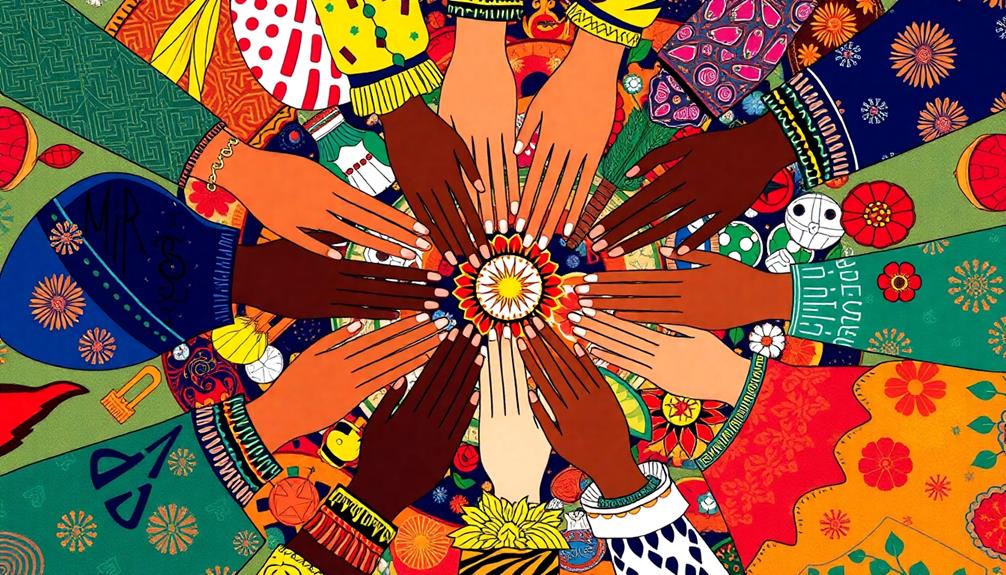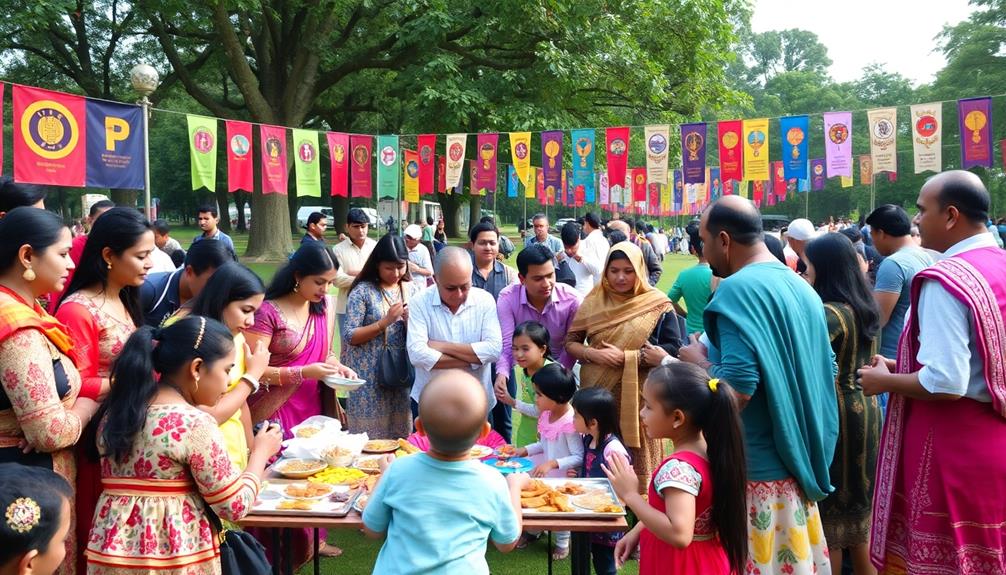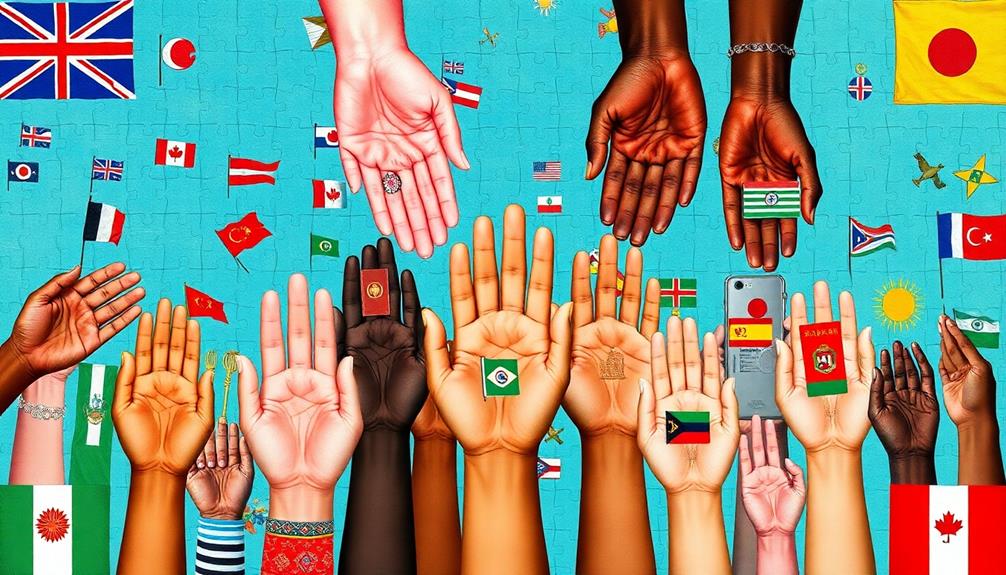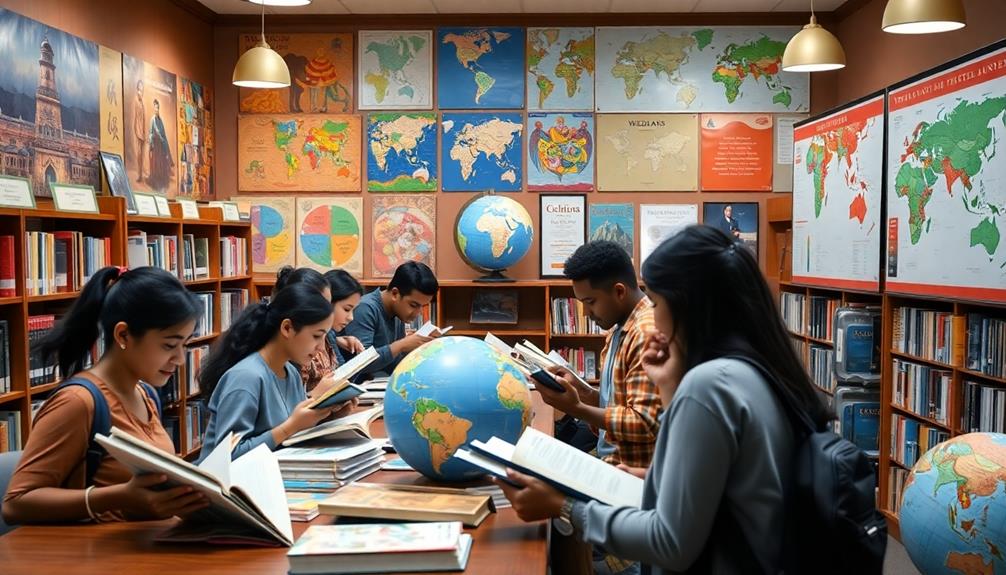If you're curious about culture, exploring diversity through inquiry can greatly expand your understanding. Culture shapes identities and influences how you see the world. By asking questions, you can appreciate the unique perspectives that different backgrounds offer. Engaging with various cultures not only fosters empathy but also strengthens your ability to communicate effectively. This journey enriches your community and helps combat discrimination. Plus, utilizing diverse viewpoints can lead to innovative solutions in many settings. You'll find that embracing diversity enhances both personal growth and collective well-being, and there's plenty more to explore that can deepen your insight.
Key Takeaways
- Engaging with diverse cultures fosters empathy, reducing prejudice and enhancing mutual respect among individuals.
- Inquiry about cultural differences enriches personal growth and broadens perspectives, leading to innovative problem-solving.
- Active participation in discussions about culture promotes a sense of belonging and community cohesion.
- Utilizing diverse voices in decision-making processes uncovers unique solutions to societal challenges.
- Ongoing education in cultural competence equips individuals with skills to navigate an interconnected world effectively.
The Essence of Culture

Culture is the heartbeat of our identities, shaping how we see the world and interact with others. It's made up of shared experiences, values, and practices that influence your worldview.
You might find yourself belonging to multiple cultures simultaneously, as factors like race, national origin, gender, class, and religion intertwine to create a unique tapestry of identity.
As you navigate through life, you'll encounter questions about your own culture and the cultures around you. These inquiries can deepen your understanding and appreciation of the diverse cultural backgrounds that enrich our communities.
Engaging with different cultures isn't just important for personal growth; it's essential for recognizing and addressing discrimination.
Importance of Cultural Understanding

Understanding different cultures is crucial for creating a more inclusive and empathetic society. When you embrace cultural understanding, you foster empathy and respect, which can greatly reduce prejudice and discrimination. This leads to a more harmonious community where everyone feels valued.
A culture of inquiry encourages you to engage with diverse perspectives, enhancing your problem-solving skills. Teams that include individuals from various backgrounds are more likely to develop innovative solutions to complex issues, as high CQ predicts success in multicultural settings.
Moreover, by engaging with different cultures, you'll increase your awareness of global challenges and sharpen your critical thinking skills. This preparation is essential as you navigate an interconnected world. Understanding cultural nuances also improves communication; it helps you recognize differences in values, beliefs, and behaviors, leading to more effective interactions.
Additionally, studies show that inclusive educational settings that prioritize cultural understanding can greatly enhance academic outcomes for students from marginalized backgrounds. By becoming culturally competent, you contribute to a more equitable environment for all.
Fundamentally, the importance of cultural understanding lies in its ability to enrich lives, promote collaboration, and build a society where everyone can thrive.
Building Inclusive Communities

Creating inclusive communities starts with recognizing the value of diverse voices in every conversation. When you engage with different cultural groups, you guarantee that all perspectives are heard and respected. This active participation allows students to feel a sense of belonging, which is fundamental for building strong relationships within and between communities.
Just like the importance of celebrating relationships, these connections foster a supportive environment for growth and understanding.
Ask questions that encourage open discussions about cultural differences and shared struggles. These conversations foster understanding and create an environment where everyone feels valued. It's essential to establish strong connections with core groups, acknowledging their unique strengths and contributions.
This recognition cultivates mutual respect and inclusivity. By utilizing diverse perspectives in community initiatives, you can uncover innovative solutions to common challenges.
Remember, ongoing education and training on cultural competence are significant for maneuvering through diversity effectively. When individuals and organizations prioritize these practices, they promote equitable opportunities for everyone.
Ultimately, building inclusive communities requires commitment and collaboration. By listening, learning, and engaging with others, you contribute to a vibrant, diverse society where all voices matter.
Let's work together to create spaces where everyone feels empowered to share their stories and experiences.
Strategies for Enhancing Diversity

Enhancing diversity in educational settings requires intentional strategies that foster an inclusive atmosphere. You can start by implementing culturally responsive teaching methods, which draw on students' diverse backgrounds and experiences. Studies show this approach can improve engagement and academic success by up to 30% for marginalized groups.
Co-creating classroom norms with your students is another effective strategy. This practice enhances feelings of safety and belonging, leading to increased participation in discussions.
Additionally, incorporating diverse primary sources—like literature and historical documents from underrepresented groups—enriches students' knowledge and skills, promoting a nuanced understanding of history and society.
Encouraging collaborative projects that tackle real-world issues allows students to explore their cultural identities while honing essential 21st-century skills such as communication and teamwork. These skills are critical in today's workforce, making this approach doubly beneficial.
Lastly, providing ongoing professional development for educators on cultural competence and diversity strategies is essential. Teacher training greatly enhances the effectiveness of diversity initiatives in schools, ultimately creating a culture where everyone feels valued and included.
Resources for Ongoing Learning

Accessing a wealth of resources can greatly boost your ongoing learning about diversity and cultural competence. Engaging with tools like the Culture Matters workbook and the Multicultural Pavilion, which offer essential insights for educators and community members alike, can be complemented by understanding the role of automation in business to enhance organizational inclusivity.
These resources can help you reflect on your own life experience and guide you in promoting an inclusive environment.
Consider the National Center for Cultural Competence, which provides strategic guidance for developing health programs that prioritize diversity. Their insights are invaluable for anyone looking to take meaningful next steps in health equity initiatives.
Additionally, online cultural competence training can foster essential dialogue about diversity and inclusion in various settings.
The Southern Poverty Law Center also offers educational materials aimed at combating hate and discrimination, supporting your journey toward racial justice.
Finally, immerse yourself in case studies and interdisciplinary approaches found in health equity journals. These highlight the importance of community action in dismantling systemic racism and enhancing cultural awareness.
Embracing these resources will empower you to not only learn but also to actively contribute to a more equitable society.
Frequently Asked Questions
What Is an Example of Culture of Inquiry?
A culture of inquiry might look like students engaging in a project where they explore local environmental issues.
You'd encourage them to ask questions like, "What impact does pollution have on our community?" and "How can we help?"
They'd research, discuss, and present their findings, actively participating in their learning.
This approach not only fosters critical thinking but also helps you create a safe environment where every question is valued, enhancing engagement and ownership.
Why Is a Culture of Inquiry Important?
Did you know that students who engage in inquiry-based learning are 30% more likely to retain information long-term?
A culture of inquiry is important because it empowers you to take ownership of your education. When you're encouraged to ask questions and explore your interests, you're more engaged and motivated.
This environment nurtures critical thinking and creativity, helping you develop skills necessary for real-world problem-solving and collaboration, thereby making learning more meaningful.
What Is the Process of Cultural Inquiry?
The process of cultural inquiry involves actively engaging with diverse cultural perspectives through questioning and reflection.
You start by asking essential questions that challenge assumptions and provoke critical thinking.
Next, you gather primary sources, like personal accounts and historical documents, to gain authentic insights.
Collaboration with peers from various backgrounds enriches your understanding, fostering empathy and appreciation for different narratives.
This journey not only enhances your knowledge but also deepens your respect for cultural complexities.
How Do You Establish a Culture of Inquiry in the Classroom?
Did you know that students who engage in inquiry-based learning are 30% more likely to retain information long-term?
To establish a culture of inquiry in your classroom, start by creating a welcoming environment where students feel safe to ask questions. Greet them at the door, co-create norms, and integrate their passions into lessons.
Encourage open-ended questions and provide structured protocols for younger students to guide their inquiries, fostering a collaborative atmosphere.
Conclusion
So, if you think culture's just about fancy food and quirky festivals, think again! Embracing diversity isn't just a trendy hashtag; it's about digging deeper and actually understanding one another. By asking questions and learning from different perspectives, you not only enrich your own life but also help build a community where everyone belongs. Let's face it, ignorance might be bliss, but that bliss is pretty boring—so why not spice things up with some genuine curiosity?









